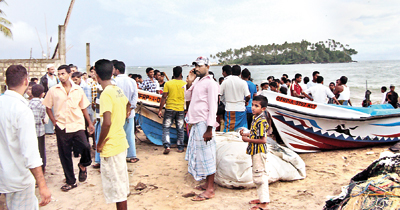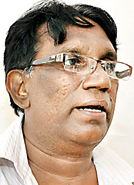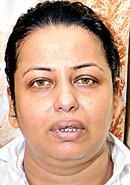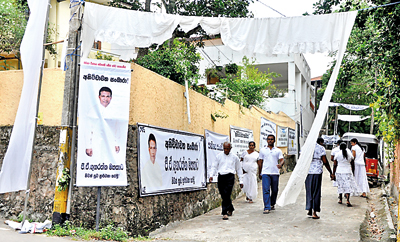Time to turn the tide
Sri Lankans can little resist water. Bathing in a waterfall, river or lake, going out to sea in a boat or having an impromptu sea bath are all an essential part of the Sri Lankan leisure itinerary – so much so that for most of us, it can be the most anticipated part of a holiday. Very few realise that sometimes, such ‘fun’ occasions may well end in disaster. Last week’s boat tragedy off Beruwela where five people drowned in the sea, left the entire country with the grave realisation of the dangers that lurk in such seemingly innocuous pastimes.

The scene of the Beruwala tragedy
On the way back home from their annual trip, the staff of the Thalangama Branch of the Sanasa Development Bank and family members, all 108 of them, were taking turns to go out to sea and visit the Beruwela Lighthouse. Thalangama branch Chairman, G.A Gunaratne, 65, along with members of his Board of Directors, decided to take the last turn and was on the boat that capsized in the choppy seas, resulting in the deaths of five of the 11 on board.
White flags draped the roads of Pelawatte as the Sunday Times visited the home of Mr. Gunaratne. “My brother was a friend to the whole neighbourhood, he was somebody who stood out for social service in the community,” said a tearful G.A. Jayaratne, brother of Mr. Gunaratne.
“No safety was assured on the boats, the only thing I can do is to urge people to be overly cautious,” he added.
L. P. Sirisena, 70, and Muiline Sirisena, 64, also victims of the boat tragedy were a happy couple spending their years in peaceful retirement. “My parents were looked upon with great respect because of the amount of social service they rendered to the area. But now they have left us with nothing but unbearable pain,” said Dilshani Panagoda, their daughter.
K.G.H. Chandrakumara and K.W. Jayawardena were also victims of the tragedy.
Mr. Chandrakumara, 59, father of two children, living in Australia, was just two months away from enjoying the bliss of retirement, but fate had scripted a most unfortunate end. Being the Deputy Chairman at Sanasa, Mr. Chandrakumara too decided to board the last boat with his long-time buddy K. W. Jayawardena, 72, who was a former Directo r of Education. Mr. Jayawardena spent most of the last few years of his life investing in his son’s passion to become a specialist doctor. His son, now practising medicine in Australia could not come to terms with the tragedy.
“The boats took off from Maradana Lellama, and carried passengers in batches. We were the last to set out, and our boat was carrying 11. Halfway through the return journey, we saw a large wave ahead and as one person shifted his weight to the back of the boat, the boat was unbalanced. This caused most of the passengers to fall over like dominoes as the wave hit and the boat capsized,” said Siri Wettasinghe, 60, one of the six survivors of the tragedy.
 Siri Wettasinghe, a survivor |
 Dilshani Panagoda lost her parents |
The boat ride from Maradana Lellama to the Beruwela lighthouse is about 1.5 kilometres, but that proved to be a bit too long for a fishing boat that was not meant to carry more than eight. “We were two to three minutes away from coming to shore, when it all happened,” added Mr. Wettasinghe.
“The boat completely overturned and we were trapped beneath it.” Mr. Wettasinghe said although he was tagged the lucky one, he feels it was not because of any luck, but because he was an able swimmer. “I dived in and swam.” A few minutes later, the passengers who managed to cling on to the boat were rescued by nearby fishing boats. “I looked around and noticed that our chairman and Mrs. Sirisena were missing, but by that time we were pulling the capsized boat towards the shore.”
What Mr. Wettasinghe, along with the others saw when they righted the boat on shore was an emotionally agonising sight – two bodies motionless inside the boat.
The Beruwela Police Station OIC said the boats that took the Sanasa staff were not equipped to carry passengers. “These were mere fishing boats that had a standard motor,” he said, adding there were no life-jackets on board.
A solid procedure of registering all boat services is not in place as fishing boats offering passenger services are mushrooming at all public beaches, but it is imperative for passenger-carrying boats to have seats, railings and life-jackets. “We advise people to look into these factors before boarding any boat,” the OIC said.
The Beruwala tragedy is one of a long line of such accidents that seem to occur with horrifying regularity. “In Sri Lanka, around 1050 lives are lost every year due to drowning, with the largest number of victims being youth,” says Dr. Wijaya Godakumbura, the surgeon who pioneered the safe bottle lamp and who is now actively involved in injury prevention. The old adage ‘prevention is better than cure’ is what he reiterates. The primary causes of drowning deaths in this country are due to lack of attention, carelessness and ignorance, says Dr. Godakumbura.
95% of worldwide drowning deaths occur in developing nations such as Sri Lanka, he adds. “Silent Death” is a term that is synonymous with drowning- a person caught up in a wave finds it difficult to scream for help, and is often carried away by the sea, he explains. But the general public is fearless – daring to plunge into unknown waters with no thought of the risks involved. We should aim to inculcate a new attitude where people think twice before putting their lives at potential risk, he says.
Dr. Godakumbura who has been working tirelessly to bring the ‘drowning’ issue to light, in his recent book ‘Protect Your Child From Injury’, dedicates an entire chapter to drowning awareness with simple guidelines for safety (see box).
“More deaths are caused as people jump in to the water to save the victim,” Dr. Godakumbura states. Out of the 1050 deaths due to drowning, 15 – 20% happen due to would-be rescuers drowning along with the victim.
“One death turns into two, and two turns into three, as more and more people jump into the water with the intention of saving the victim.”
“We cannot ask people not to jump into the water to save a friend, it is a genuine reflex action, but what we can do is to ensure that there is proper equipment to aid the rescue.” The recommended method is to use a long pole and pull the victim towards the shore, while maintaining a firm footing. Floating devices and rescue aids need to be located at all places of bathing, and at public beaches, and this should be the responsibility of the local government authorities, he says.
Two of the major reasons for death by drowning , is the lack of life-jackets as well as consumption of alcohol. In the case of the latter, your reflexes are slow. If drinking and driving is banned, why not a law banning the consumption of alcohol at swimming hotspots asks Dr. Godakumbura. Statistics show that 25 – 50% of young people who drowned were under the influence of alcohol, he points out.

A village in mourning: The scene at Pelawatte. Pix by Indika Handuwala
Statistics also show that 90% of deaths occurring in boat incidents were due to the lack of life-jackets. “First came the helmet law, followed by the seat belt law, and people adhere to them knowing the dire consequences of not doing so, so why not implement a life-jacket law, making it absolutely necessary?” Dr. Godakumbura questions. A life-jacket is one of the primary things that you need to look out for when boarding such a boat. “If life-jackets were made compulsory, the Beruwela tragedy along with many untold drowning stories would have been averted.”
Another aspect is the issue of being trapped in a rip current, as mentioned in his book. A rip current is essentially a strong channel of water flowing seaward from near the shore. Dr. Godakumbura explains that rip currents can be identified by their foamy appearance, more specifically if a large glob of seaweed is seen to be carried away towards the ocean surrounded by the foam. A rip current may carry you some 300 feet away from the shore. Trying to swim directly back to shore, once caught up in a rip current, should be avoided. The wiser option is to remain calm and swim parallel along the shoreline until you escape its grasp.
70% of all persons subjected to drowning, rescued and given first-aid within seconds live to tell the tale. This has led the World Health Organisation to redefine the word ‘drowning’. The revised definition states: “Drowning is the process of experiencing respiratory impairment from submersion/immersion in liquid” – leading to the fact that drowning does not always end in death as previously believed. “It is universally accepted that first-aid given by bystanders, till the victims are professionally attended to, can save lives,” says Dr. Godakumbura. Thus it is vital that every citizen garners at least a basic understanding of giving first-aid.
Living in an island makes it only natural that we take to water, but safety should be uppermost in our minds when confronted with the tempting prospect of a boat ride, dip in a lake or sea.
Safety guidelines
- Always look for life-jackets before boarding a boat, and make sure you wear one throughout the ride.
- Balance out weight equally on a boat; avoid sudden movements.
- Look around for long poles, sticks or floating objects which can be used to pull in victims.
- Only jump in to rescue a person if you are an able swimmer.
- If you feel that the victim is pulling you down through panic, let go of him and return to shore, or else, one death certainly will be two.
First-aid
- After taking the victim to the shore, check for vital signs i.e pulse and heart-beat.
- If either one of the two are low, lay the person flat and start mouth-to-mouth resuscitation by blowing air into his mouth, every five seconds.
- Massage the front of the chest with the back end of your palms.
- Take the victim to the nearest hospital even if he/she regains consciousness.
Follow @timesonlinelk
comments powered by Disqus



















